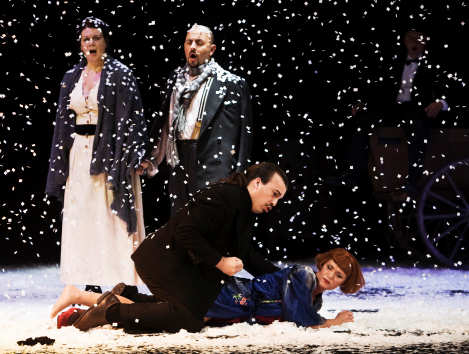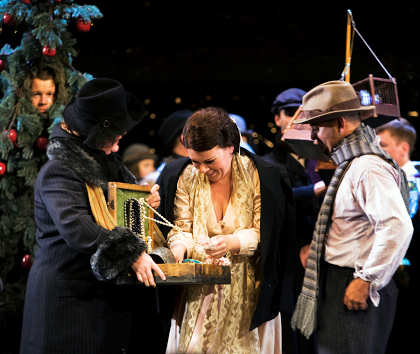Other Links
Editorial Board
- Editor - Bill Kenny
- London Editor-Melanie Eskenazi
- Founder - Len Mullenger
Google Site Search
SEEN
AND HEARD INTERNATIONAL OPERA REVIEW
Puccini, La bohème : at Värmlandsoperan, Karlstad, Sweden, 18.9.2008 (GF)
Directed by Peter Konwitschny
Sets and costumes by Johannes Leiacker
Lighting design by Steffen Böttcher
Cast:
Mimi – AnnLouice Lögdlund
Musetta – Anna-Maria Krawe
Rodolfo – Jonas Durán
Marcello – Anton Eriksson
Schaunard – John Sax
Colline – Johan Schinkler
Parpignol – Christer Nerfont
Benoit – Henrik Hugo
Alcindoro – Peter Boman
Värmlandsoperan’s Sinfonietta and Chorus, Young Värmlandsoperan’s
Chorus, extras, stage musicians and dancers.
Conducted by Per-Otto Johansson
Since 1975 the province of Värmland in Western Sweden, bordering on
Norway, has had its own opera company in the City of Karlstad on the
north side of Lake Vänern, the third largest lake in Europe. The
opera house, beautifully situated a stone’s throw from River
Klarälven, was built in 1893 and the architect, Axel Anderberg, also
designed a number of other theatres, including Oscarsteatern and the
Stockholm Opera. It is a beautiful but small venue, seating at the
most 397 onlookers. Originally intended for spoken theatre and
between 1917 and 1975 used for cinema, the acoustics are on the dry
side but the intimate size implies that the audience come very close
to the action. Sitting in the last row but one in the stalls I was
still closer than when seated in the front row in many large houses.
As in practically every Puccini opera there are of course also
comical elements and Konwitschny also brings these to the fore and
doesn’t hesitate to include some burlesque scenes – even some
risqué ones. Musetta’s and Marcello’s unblushing copulation on
the front catwalk in Act II was certainly not to everyone’s liking
but it added something to the picture of their animal attraction to
each other. Completely avoiding sentimentality in a production of
La bohème is probably impracticable – Puccini has built it into
the music – but Peter Konwitschny has managed to tighten things up
and I suppose that he has had some views on the musical
interpretation as well. The conductor of the evening, Per-Otto
Johansson, chose generally brisk tempos and there was a rhythmic
lilt in several places that felt totally refreshing. Konwitschny
even mentions Toscanini’s recording of the opera from 1946 which
proves that ‘this music/…/ isn’t foredoomed to survive as emotional
mishmash.’ With an orchestra of 34 players and acoustics reminiscent
of the notorious dryness of NBC’s Studio 8H there was more than a
fleeting likeness with the Italian maestro who, by the way,
conducted the world premiere back in 1896. The 28 strong chorus was
also more than satisfactory and the children’s chorus in Act II was
well drilled and charming.

This production of La bohème was premiered on 5th August and
will be played until the end of November. It was originally staged
at Oper Leipzig in Germany but I suspect that Peter Konwitschny and
his team had to adapt it quite drastically to squeeze it into this
venue. They employ not only the stage but also boxes close to the
stage and a kind of catwalk surrounding the orchestral pit, which
further contributes to the close contact between actors and
audience. Costumes are rather timeless and in no way spectacular,
apart from Musetta’s extravagant and rather alluring outfit. In the
second act, at Café Momus on Christmas Eve, Johannes Leiacker
literally wallows in extravaganza with a throng of dressed up
characters, including a couple of walking Christmas trees, a
full-size Christmas present, also walking, wrapped in white and
with a red string, and clever use of the revolving stage to further
heighten the impression of crowd. The other three acts are however
very sparse. In the first there is the stove, where they burn
Rodolfo’s play, and Marcello’s easel with his very wide painting,
later used as table for the starving Bohemians. In the background we
see a panorama of illuminated Paris. In Act III Marcello’s painting
is leaning against the wall to the left, marking that the tavern is
even further to the left. There is heavy snowfall, which continues
in the last act, taking place not in the attic from act one but in
the street. In Konwitschny’s reading the Bohemians have obviously
gone to the dogs, a social decadence comparable to The Stockholm
Opera’s cynical and hard-boiled recent La traviata. In this
setting Colline’s grandiose Il Re mi chiama al minister (The
King wants me as minister) so obviously reveals the gap between
dream and reality. We need dreams of course, sometimes the only
thing that gives some gilt edge to one’s existence and it is
possible to interpret Konwitschny’s reading as in some sense
Darwinist: the survival of the fittest. Anyway, we come closer to
these characters’ true selves than in any staging of this opera I
can remember. There were so many finely observed details of
psychologically credible behaviour, from Mimi’s cute shame in the
first act when Rodolfo tells his friends, Non son solo. Siamo in
due (I’m not lonely. We are two) to the Act III scene between
the two, where Mimi has overheard the dialogue between Rodolfo and
Marcello and learnt that she is already doomed. But so caring in the
midst of her desperation is she that she takes up Rodolfo’s
jacket from the ground and puts it over his shoulders. It is of
course a tragedy and I believe that few eyes were dry when the last
notes had died away. Unusually the curtain remained open and the
characters remained in frozen positions for a very long time – and
there was not a trace of applause until Mimi eventually started to
move and the whole ensemble got to the front of the stage. Life goes
on. Business as usual.

Mimi
– AnnLouice Lögdlund
Among the soloists AnnLouice Lögdlund stood out as the star of the
evening, less through volume and brilliance but through restraint
and nuances. She was excellent from her first entrance but grew
during the performance, charging Donde lieta usci in Act III
with emotion and she was deeply touching in the final scene of the
opera. Jonas Durán as Rodolfo and Anton Eriksson as Marcello are
both in the beginning of their professional careers and with some
more experience they will surely be important members of any
ensemble. They took some time to warm up but in the third act they
impressed greatly. Anna-Maria Krawe was a charismatic Musetta – the
bitchiest I’ve seen – and Johan Schinkler as Colline sported a
monumental bass voice that should be an asset also in Wagnerian
roles. His philosopher was rather hot-tempered and not the stoic we
normally expect. John Sax, whom I once saw as a fine Eugene Onegin,
was an expressive Schaunard and like all his colleagues he was a
vivid actor.
The performance was sung in Italian with Swedish surtitles and with
only one intermission – between Acts II and II– and no breaks
between the other acts, the sense of unity and inexorable forward
movement became extra strong. This is indeed a La bohème to
treasure.
Photos © Johan
Eklund
Back
to Top
Cumulative Index Page
